William A Balk, Sr.’s “Wartime Experiences of a Colorblind Navy Pilot—6”
“We’ve been hit.”—By William A. Balk, Sr.
Dispatches from The Esso Club
By Ted Balk
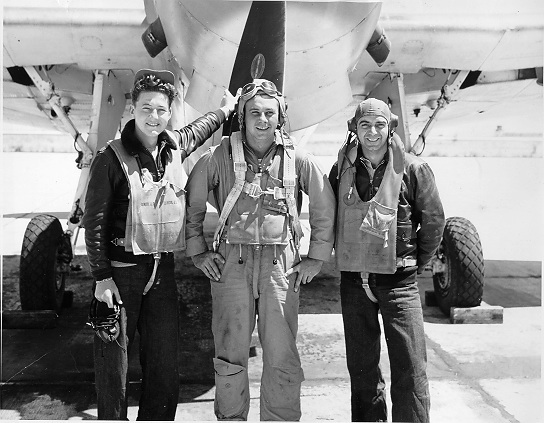
Note by Ted Balk: This sixth installment of my late father’s memoir continues the saga of his wartime experiences as a Navy pilot. Previously published installments on Weekly Hubris are:
Installment 1—Foreword & Preface https://weeklyhubris.com/william-a-balk-sr-s-wartime-experiences-of-a-colorblind-navy-pilot/;Installment 2—Shakedown Cruise to Guadalcanal https://weeklyhubris.com/william-a-balk-sr-s-wartime-experiences-of-a-colorblind-navy-pilot-2/; Installment 3—Invasion of Palau (Part One) https://weeklyhubris.com/william-a-balk-sr-s-wartime-experiences-of-a-colorblind-navy-pilot-3/; Installment 4—Invasion of Palau (Part Two) https://weeklyhubris.com/william-a-balk-sr-s-wartime-experiences-of-a-colorblind-navy-pilot-4/; and Installment 5—Invasion of Palau (Conclusion) https://weeklyhubris.com/william-a-balk-sr-s-wartime-experiences-of-a-colorblind-navy-pilot-5/.
CENTRAL South Carolina—(Weekly Hubris)—10/13/2014—
CHAPTER III
The Invasion of Leyte

By October 2, the Marines had established their own air support group on Peleliu with a squadron of F4U Corsairs, so we were granted a brief respite with a trip to the anchorage at Manus Island in the Admiralty group. While the ship took on fuel, supplies, aviation gasoline, and ammunition, the pilots could spend a few days ashore relaxing.
There wasn’t much to do except swim, drink beer, and play baseball. But physical activity in the equatorial heat was enervating, to say the least, so mostly we swam and drank beer and slept. The anchorage at Manus was teeming with ships of all kinds: battleships, cruisers, destroyers, troop ships, tankers, supply ships, and every kind of landing craft. While we were at Palau, this group had been assembling and re-arming in preparation for the assault on the Philippines.
On October 12, the invasion force left Manus and headed towards Leyte Island in the Philippines. The air operations in this assault were to be conducted about the same as they were during the Palau invasion but, this time, we had 18 carriers (CVEs) with 18 composite squadrons. The carrier force was divided into three groups with code names of Taffy 1, Taffy 2, and Taffy 3. Each Taffy had six CVEs and six DDs or DEs. Our group was Taffy 2 and our carrier, the Marcus Island, was Famous Base. VC-21, our squadron, was Famous Squadron and I was Famous 87. Each pilot had his own Famous number. These codes were used mainly for radio communication. I should mention that with the exception of the Taffy designation, these codes had been used during the Palau campaign.1
We arrived within striking distance of Leyte about four days after leaving Manus and found a full-blown typhoon between the beachhead area and us. This delayed the close support operations for a couple of days, but we kept up the ASP and CAP as usual. Since the danger of fighter attacks here was much greater than in the Palau area, the ASP planes were assigned a fighter wingman for additional protection. As luck would have it, on one flight I was assigned an ASP quadrant to patrol that included the typhoon.
Tubby Clevenger was flying wing on me as my fighter escort, and we were covering our assigned area without any excitement until we got close to the typhoon. I asked Tubby if he wanted to see what it was like in there, and he nodded in the affirmative. We headed straight in and right away we were getting bounced around severely. We had been in the storm about two minutes when my plane hit a down draft that slammed my head against the top of the canopy and almost knocked me out. At the same time, Tubby hit an updraft and immediately disappeared. Later on, we figured he went up about 500 feet and I went down about 500 but, at the time, I didn’t know where he was and he didn’t know where I was and we sure didn’t want to run into each other trying to find out.
I headed out of the storm as fast as I could and continued the patrol, but didn’t see Tubby again until we got back to the carrier. After the experience with the storm in Palau and now this one, it began to dawn on me that these storms were best left alone. Of course, this is what the weather people had been telling us ever since we’d starting flying.
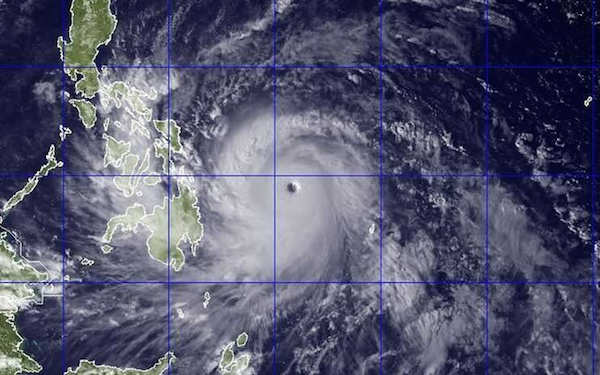
By October 18, the storm had moved on and we were able to start softening up the beachhead. The combined air components of the fleet bombed and strafed the area just inland from the beaches continuously. Once, we managed to catch a convoy of trucks moving up with troops and supplies. Our wing guns tore them up pretty well and set them on fire. They never got to their destination. We also extended the ASP to cover Surigao Strait, which potentially afforded an entry to the beachhead area from the south and west by the Jap fleet. Our admirals must have considered this a serious threat because they assigned two TBMs at a time to make this patrol. Later on, it turned out that their fears were well founded.
On the afternoon of the 19th, Hamilton and I were assigned to patrol this area, which we did without sighting anything but Philippine fishing boats. Every time we flew over one of them, they would stand up and salute. On the way home, I was flying the lead with Ham on my left wing and the irregular coast of Dinagat Island just off to my right. We were headed north, back toward the mouth of Leyte Gulf. Dinagat is rather hilly and, as usual, we were flying low over the coastline so that when the land jutted out into the gulf we just pulled up to go over the hill, then dropped down on the other side.
On one of these hop-overs we ran up on two American destroyers in the process of shelling the shoreline. It turned out they had just been attacked by a Japanese plane, and they were understandably very trigger-happy. They were excellent shots, as well. Their first round of AA was dead on and maybe 75 feet in front. I could see the shrapnel glittering in the sunlight, and we were headed straight for it. I figured Ham hadn’t seen it because he was watching me, but I knew he would try to stick with me as close as he could. I pulled up sharply in a hard climbing turn to the left so that my left wing tip was practically in his face, but he could slide under me, make the same maneuver I had, and come out flying on my right wing.
All of this was done without any conscious thought or plan on my part, but rather as a reaction to the situation. Because of our intensive training together, I knew instinctively what Ham would do in this situation and that this would put us on a course at right angles to the destroyer’s line of fire. If I had turned right, with him on my left wing, he would have wound up trailing far behind me.
There are very few gunners who will aim far enough ahead at this angle to get a hit, unless they grew up shooting doves over a corn field in the South. I looked back and, sure enough, they were shooting behind us. I hoped that as soon as they saw our profile they’d recognize the pregnant turkey shape of our TBMs and quit shooting. They did, and pretty soon their CO was on the radio apologizing. I assured him that it was our fault and that he had some mighty fine gunners. He agreed and told me about the Jap plane and said they had shot him down. We parted company as good friends. Hamilton never did see how close we came to getting hit and wanted to know what the hell I was doing.
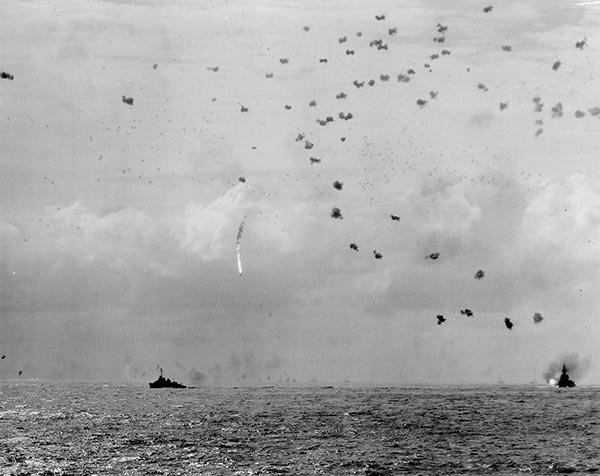
“D” day for Leyte had been originally scheduled for October 18, but the typhoon forced a two-day delay. The initial landings were rescheduled for “A” day, October 20, with “H” hour at about 10 a.m. I don’t recall what the rest of VC 21’s TBMs were assigned to do the morning of the 20th because I wound up with another special assignment and didn’t get to go with them.
Of the six CVEs assigned to Taffy 2 for this operation, two had been previously designated as flagships, which meant that they each had an admiral aboard. Marcus Island had Admiral Sample and Natoma Bay had Admiral Stump. In the Navy, seniority means everything and, since Admiral Sample was junior to Admiral Stump, he didn’t have anything to be admiral of at this time. I suspect he was getting very bored. Then he got a wonderful idea. He decided he should make personal observations form an aerial viewpoint of the entire landing operation so that he could make a first-hand report to ConAirSoPac. Somehow or other I was assigned to be his pilot. That’s when the fun began.
The first problem we hit concerned a parachute harness for him. We didn’t have one big enough. It wasn’t that he was too tall, although he was several inches taller than I. He was too big around. Somehow or other, the parachute riggers rebuilt a harness that he could use. The next problem was that he wanted to ride in the gun turret so that he could “shoot some Japs.” We tried, but there was no way we could squeeze him in. This meant he would have to ride in the radio compartment in Jim Edinger’s place.
Until then, I had assumed we would have to do without our regular turret gunner. With the fighter cover available this didn’t bother me as much as having to leave my radioman behind. I finally decided the best thing to do was to put Jim in the turret during take-off and landing; then he would be available for the radio equipment at other times. Jim also had some turret training, so this was a reasonable compromise.
Prior to the flight, I was summoned to the bridge so that Captain Greber and the admiral’s staff could impress upon me the importance of not doing anything that might endanger the admiral. My mission was to stay off to one side so that he could see what was going on, but not get involved with anything dangerous. I was to join a group of TBMs that would be on call for bombing the beachhead, but I would not be a part of their activities. All of this took place on October 19, “A” day minus one.
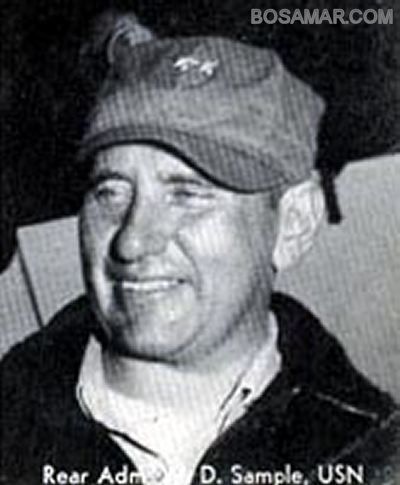
We were scheduled to take off at about 8 a.m. on “A” day. We were the only TBM to be launched at that time, but we had eight fighters as an escort. Just as the catapult fired and acceleration started taking over, the map case flew out of its retaining slot and landed in my lap. During a catapult launch, because of extreme acceleration, you aren’t able to move until the catapult releases the plane. All the maps, the code letters, the navigation information, etc. were swirling around in the cockpit or flying out the window. One piece of paper spread across my face so I couldn’t see. As soon as the acceleration eased off, I pulled the paper from my face and threw it out, slammed the map tray back into its slot, started the landing gear to retracting, eased the flaps up a little, and dropped down close to the water so we could pick up a little more flying speed, then eased off on the throttle before the engine could start detonating.
When I got things under control, I called Edinger on the intercom to find out how the admiral had made out during the launch. He had the intercom rigged so he and I could talk, but the admiral couldn’t hear us. He thought the admiral was OK. He looked a little bug-eyed but, other than that, he seemed OK. Jim reported that we did have one problem, though. During the launch, the main radio antenna had broken and was wrapped around the 50-caliber gun in the turret. If he tried to use the turret, it would probably finish breaking the antenna loose and we would lose use of the radio. We decided that we better not operate the turret unless we had to.
The fighters joined up with us and started weaving their patterns ahead and to both sides. It felt good to be important enough to have eight fighters protecting us: usually, we had zero.
Normally, the senior pilot in any formation is assumed to be the leader and, consequently, navigator for the group. Of course, this does not relieve each pilot of the responsibility of doing his own navigation and staying geographically oriented at all times. Until this time, we had made very few flights with fighters flying as protective escorts for the TBMs. In the few instances this had occurred, the senior pilot had always been in the lead TBM, and the fighters automatically oriented themselves in relation to his plane. On this flight, Al Austin, who was leading the fighter group, was two ranks senior to me. Prior to take-off, it hadn’t occurred to us to check with each other about who would take the lead. I assumed he would, even though I knew it would make more sense for the TBM to be the lead plane because of the nature of the formation.
After we had been flying for about 15 minutes, I realized we were taking a very circuitous route to the target area. I finally decided I’d better break radio silence to find out what was going on. I asked Al where he was going. He responded that he was just about to ask me the same thing. I said I was following him. He said he was following me. I said I thought one of us ought to be leading and he was the senior pilot. He said, yeah, but you’ve got the admiral aboard, so that makes you the senior plane. Well, this was logical so I changed course and headed for the beachhead.
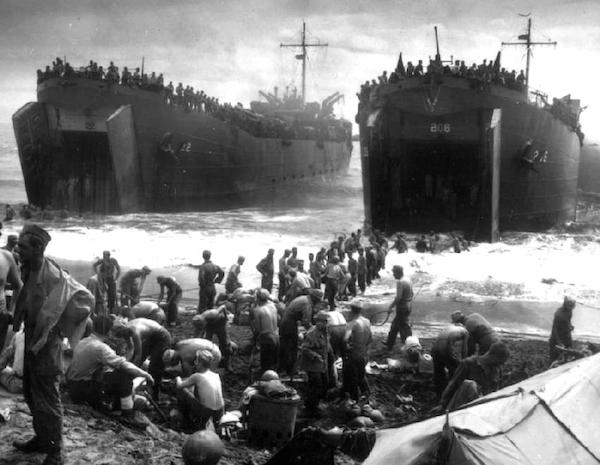
We arrived at the invasion area off Orange Beach about 30 minutes before H hour. I joined the group of orbiting TBMs as instructed, and we started circling over the invasion armada. This went on for about ten minutes; then the admiral got on the intercom. He had got Edinger to show him how to make it work.
The admiral said, “Willy, what are we doing?”
I said, “We’re flying around in circles, at the tail end of these other planes, like they told me to do back at the ship.”
He said, “Is this all we can do?”
I almost laughed because I felt the same way. Then I said, “No, Sir, not if you tell me to do something else.”
He said, “I sure as hell don’t want to keep on doing this.”
I said, “OK, neither do I. There are some planes making bombing and strafing runs on the beachhead now; we could slip off from here and tag along with some of them.”
He thought that was a good idea, so we slid in behind a group of TBMs as they made their run. I fired the wing guns a few times to make it sound realistic and went in low so he could see the bombs exploding and get a feel for the action. On our third pass, the smoke was getting so dense that we couldn’t see what we were doing. I started pulling out of our dive when—Zap!—a diving, strafing Wildcat fighter went by slightly ahead and ten feet off my left wing. Another went by ten feet off my right wing. Apparently the TBMs had retired from the area and the fighters had started their runs. I was intruding and had almost caused a triple mid-air collision. Edinger was riding in the turret and saw how close we had come to causing a catastrophe.
He whispered in the intercom, “Did you see that?”
“Yeah, how about the admiral?”
“He’s looking out the side window, but I don’t think he saw them.”
I said, “OK, we’re getting out of here now.”
I pulled out of that mêlée and found a tranquil area inland where we could safely watch all the commotion from a distance. I told the admiral we would have to let the fighters do their jobs now and stay out of their way for a while. He responded that he understood and that, anyway, what he really wanted to do was to shoot some Japs. I suspect he’d overheard our whispered conversation.
A day or so earlier, on an observation flight, we had discovered some freshly dug zigzag trenches about five miles inland from the beachhead. We’d reported their location and checked them out, but couldn’t find any activity in the area. We decided to leave them alone but keep our eye on them until the ground troops started moving inland.
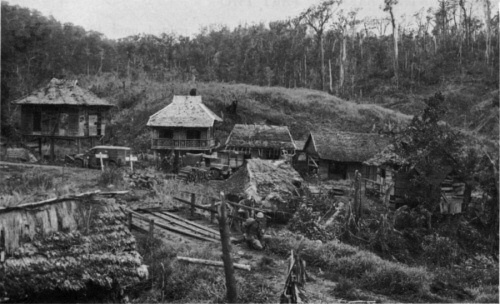
When the admiral said he wanted to shoot some Japs, I thought about these trenches. I told him about them, but sort of left the impression that they probably had Japs in them, and if we flew directly over them he could use the 30-caliber “stinger” mounted at the back of the radio compartment to strafe them effectively. He thought this was a great idea, so I warned him that the Japs would probably hunker down real low in the trenches and would be difficult to see and hit. He said he understood and thought he could handle that if I flew directly over the top of them.
We made several passes and I could hear the stinger chattering away. Finally the shooting stopped, and Edinger reported that the ammunition was used up and the admiral was very happy, because he said he knew he got some of them.
By this time, “H” hour was at hand so we went back to the beachhead and started flying a rectangular pattern over the area. There was no other aircraft activity going on now, and the ship-to-shore bombardment had moved inland in anticipation of the first wave of landing craft hitting the beaches. This meant that we had to fly below the naval gunfire trajectory on the seaward side of the beachhead and above their trajectory on the land side to avoid getting hit accidentally. We had been there long enough to see the first two waves get ashore successfully and were over the northern end of Orange Beach headed inland.
Suddenly, there was a terrific explosion. I knew we’d been hit and at first assumed it was from accidental friendly fire, and that I had miscalculated the safe altitude. Later on, we determined this wasn’t the case, but at the time it seemed reasonable. The controls were OK, so I tried to get Jim on the intercom. It was dead. I checked for visual damage and all I could see was a large gap in the trailing edge of the left wing where it joined the fuselage.
In these planes, the wing is fastened to the fuselage in two places, the wing hinge near the trailing edge and the wing lock near the leading edge. The damaged area seemed to be near the wing hinge but, since the wing was still on, I figured the hinge was probably OK. It was obvious that the left wing flap was severely damaged, but this wouldn’t be a problem until we started to land. It was also possible that the landing gear had been damaged, but I decided not to check it out because if it went down but wouldn’t retract, it would be down if we had to ditch the plane. I could see that Edinger was not in the turret, so I figured he was OK and busy in the radio compartment. I headed for home.
A few minutes later, I felt somebody punch me on the shoulder. I looked around and Jim was looking through the gap between the fuselage housing and the armor plate that separated the cockpit from the electronic gear compartment. I could see part of his face and could read his lips.
“We’ve been hit.”
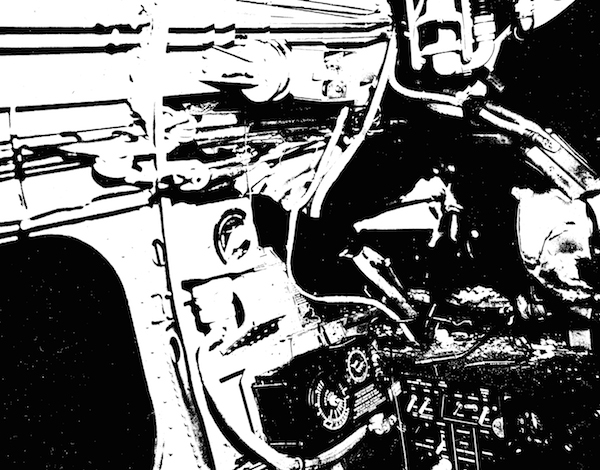
I nodded and asked if he was OK. He nodded. I asked about the admiral. He had a pad and a pencil, so he wrote a note. The admiral had been hit and was bleeding badly. He had bandaged him and applied compresses, but he thought the admiral needed medical attention. I told him we were headed home now and estimated how long it would take. He went back to check on the admiral and, a few minutes later, came back to remind me that we still had the bombs aboard. I had forgotten them. If we had tried to land with four 500-pounders aboard and no flaps, we surely would have regretted it. I thanked him and said I would jettison them, then asked about the admiral. He said he had given him a shot (morphine, probably) and the bleeding had slowed considerably. His biggest problem now was keeping the admiral awake. The turret is located above and ahead of the seat in the radio compartment, so Jim, up in the turret, would prod the admiral with his foot and holler, “Wake up, Admiral, wake up.”
Later on, I learned that one of the two parachutes available in the rear compartment had been destroyed when the shell came through. I don’t know how they planned to resolve the issue of who would use the good one in case we had to bail out. I don’t think either of them realized this was the situation at the time, but I’ve often wondered how they would have resolved the problem if it had arisen. My feeling is that Admiral Sample would have pulled rank on Jim and ordered him to take the “chute” and jump.
We got back to the ship ahead of the scheduled landing time and, since the radio was out, I flew low by the bridge to make visual signals requesting an emergency landing. I intended to keep harassing them until they started turning into the wind, but they responded immediately. I learned later that they didn’t bother to check the number on the plane, so they didn’t know it was me with the admiral aboard. They had noticed the damage to the plane, and that’s what motivated them to act promptly.
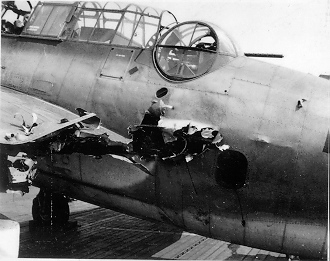
I got in the landing pattern and started my final approach, timed so that I would be in position for the “cut engine” signal shortly after the ship was ready to take us aboard. I wanted to land as quickly as possible without a wave-off.
Since one landing flap was partially destroyed and the other was OK, if I extended them, the extra lift from the “good” side might cause the plane to roll or at the very least could cause severe problems of control. I don’t think many “flaps up” landings had been made on CVEs. I doubted this was going to be the first, but I’m sure it was a first for our ship, for our landing signal officer, and for me.
As soon as I got in the approach pattern, Robbie signaled for me to put down the flaps. I wobbled the wings to acknowledge and did nothing. A few seconds later, he signaled again. I wobbled a little more aggressively. He signaled for flaps again and also that I was much too fast. I wobbled real hard, hoping that he would understand that I knew what I was doing and didn’t want him to give me a wave-off.
By then Robbie had figured out who was flying the plane and made the decision to land us if he possibly could. Most of the LSOs could tell who was flying a plane by the way they handled it during the approach. I don’t recall the landing speed of these planes without flaps, but it was considerably higher than with flaps. This meant that the LSO would have to give the “cut” signal somewhat earlier than normal for the tail hook to catch an early cable. With the extra speed, if it caught a late cable, we would surely go into a barrier anyway. On the other hand, if he gave the “cut” too early, the plane might not reach the flight deck and would crash into the ship’s fantail with disastrous results. Robbie handled it perfectly, and we greased it in and caught the first wire for one of the smoothest landings ever.
As soon as we stopped rolling, I killed the engine and located Doc Kloth at his assigned station in the catwalk near the island. I motioned for him to come to the back of the plane and indicated there was an injured man aboard. This was the first time he had ever been called on for anything other than heat rash since he’d joined the squadron over a year earlier. He actually ran to the back of the plane, just in time to help Admiral Sample climb through the radio compartment door. I looked back from the cockpit and could see the admiral with a bandage on his head, another on his shoulder, and another on his arm. He had bloodstains on his face and all over his uniform but, otherwise, he looked pretty healthy. By then, the Brass on the bridge had realized who was hurt, and they all erupted onto the flight deck to help him off.2

Several days later, Jim and I were “invited” to the admiral’s quarters for a cup of coffee. We talked it over and decided we ought to accept the invitation. We enjoyed a short visit with him and his aides and rehashed the flight for their benefit. They all expressed their gratitude, and the admiral gave Jim a promotion on the spot.3 Both Doc Kloth and the ship’s doctor commended Jim for his expertise in administering first aid. The ship’s doctor asked Jim what he thought of the medical profession now that he’d had a chance to practice. Jim replied that he thought it was a pretty good racket.
At that, Captain Greber howled, “He’s got you figured, Doc. He’s on to you. I told you that you couldn’t keep fooling these people all the time, ha, ha, ha.”
Later on, we had a chance to examine the damage to the plane to determine what kind of ordnance had caused the explosion. There was a clean entry hole about four or five inches in diameter on the right side of the fuselage, just above the trailing edge of the wing. The projectile tore through the radio equipment until it reached the fuselage on the other side, where it exploded. The main force of the explosion was away from the fuselage and toward the wing and flaps on the left side.
At the time of the blast, Admiral Sample was standing about two feet from the explosion, with his right arm over his head holding on to part of the fuselage framework. He was looking out the window toward the beachhead as we crossed over it heading inland. His right arm and shoulder absorbed most of the shrapnel and blast rather than his head and neck because his arm was raised.
It seemed obvious from the damage that a Japanese mortar at the top of its trajectory had hit us. It had been fired from an inland area on our right and targeted for the assault troops on the beachhead. This analysis has been corroborated recently in an account of the Leyte invasion in which the author states that the only effective resistance by the Japanese on “A” day came from mortars located behind a hill to the right of Orange Beach. The admiral’s attitude was that maybe we’d saved some GI’s life by intercepting that mortar round.
To get back to the action, my flight log shows that we made another flight that afternoon for glide bombing attacks on Leyte. We must have returned to the ship after dark because my logbook is credited with a CL in red, which means a night carrier landing.
Over the next two days, we made four more flights, three of which included an Army lieutenant, named Baldwin, who rode as an observer.
On one of these flights, I was scheduled for a pre-dawn take off along with Tony Peyou. We each were to have an Army observer for the ground troops on Leyte. Shortly before take-off, Tony asked me to swap planes with him. He was assigned plane Number 23, which he said was jinxed for him. Every time he flew it something went wrong, so he would rather not take a chance on it that morning.
I didn’t have a problem with jinxes so I said OK. Number 23 was closest to the catapult, so I was the first one launched. Everything went OK and I gained altitude and started circling for Tony to join up. The plan was for us to fly to Leyte together; then report to our respective sectors for the rest of the flight. Tony didn’t join up when he should have, so I figured something was wrong. A few minutes later, I saw tracers being fired into the dark sky from the ocean surface behind the carrier. This meant Tony was in the water and using his .38 caliber revolver to fire tracers so that the destroyer behind the carrier could locate him in the dark. Already, there was a destroyer heading for them. We all carried revolvers with tracers in shoulder holsters specifically for this purpose.
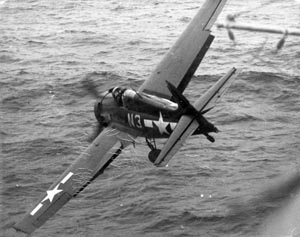
Later on, I learned what happened. Just as the catapult fired, the engine on Tony’s plane conked out cold. His plane went off the flight deck into the ocean straight in front of the ship. Tony and his regular crewmen managed to get out of the plane before they were plowed under by the ship’s bow. As the ship passed over them, they kept pushing down and away from the hull, hoping to avoid the propellers at the stern. All three survived, but no trace of the Army observer was found. The regular crew was thoroughly familiar with emergency procedures and managed to keep their heads during this ordeal. The Army observer would surely have been disoriented and confused, to say the least.4
Since it was obvious that we couldn’t be of help, we headed for Leyte to carry out our assigned mission. This flight and the next one that afternoon turned out to be routine and uneventful. The Army just couldn’t figure out how to make the best use of our capabilities.
The next day turned out to be more exciting. We made another pre-dawn take-off and arrived over Leyte shortly after sun-up. There didn’t seem to be much business for us from ground control, so we decided to drum up our own. We figured that if we could get below the banks of the river just south of the beachhead, then fly inland, we could get behind any Japs in that area before they knew we were coming. We hoped they wouldn’t have time to disappear like they usually did, so maybe we could do some damage. The riverbanks with the trees lining them were about 15 or 20 feet high, so we had plenty of room to get below the Japs’ line of sight.
This seemed to be working well; then we went around a sharp bend to the right. There, on our left, in the early morning sunlight, stood eight or ten beautiful, teenaged Philippine girls, ankle deep in water, nude and obviously bathing. We were slightly above eye level as we passed by them about 20 feet from our left wing tip. They started waving as we went by. We pulled up immediately and came around for another pass. By then, some nuns had come running from the church nearby, and the girls were scrambling for towels. The next time we came by, they waved again, but this time they were covered up. The sisters vigorously shook their fingers at us, so we waggled our wings and went on.
Later on, when I was at home on leave, I was invited to the regular luncheon meeting of the Augusta Rotary Club. A young lady reporter for one of the newspapers was there and asked for an interview. One of her questions was, “What was your most exciting experience in the war?” I told her about the girls in the river. The paper printed it.
On one of these final flights during the Leyte assault, I was orbiting just off the beachhead over the ships of the Task Force. I spotted a lone plane making what looked like a torpedo attack on one of the support ships. I had plenty of altitude, so I figured I could get above and behind him when he came out the other side. He did exactly what I expected, so I was in perfect position to hit him with the wing guns. I had just started pouring lead into the engine area when I suddenly realized I was shooting at a TBM. I was so shocked that I immediately broke off the attack and dove past him while he was still climbing. During the entire episode, I had been keeping Jim and Al informed on what was going on and what I was planning to do. As soon as I broke off the attack, I was on the intercom.
“That was a TBM I damn near shot down.”
Al came back with, “Yeah, but it had meatballs on the wings.”
Jim confirmed the Jap markings, but I hadn’t seen them and I was looking straight down on the plane from above. I missed a good chance to shoot him down, but once I got out of position I couldn’t catch him without jettisoning our bomb load. I couldn’t do this over our own ships, so he got away.
This episode points out how easy it is to mis-identify and get involved in friendly fire. When I saw the plane making a torpedo run, I knew it had to be a Jap. No American plane would be doing what that plane was doing at that time. My mind did not even register the possibility that this could be anything but a Jap plane. When I suddenly recognized it as a TBM, I was dumbfounded; I never even looked for the insignia. I was horrified at the possibility that I was shooting at one of our own, and the possibility was real that I could have misinterpreted his flight pattern across the group. I regret that I lost the opportunity to get credit for a Jap plane, but I’m thankful that I didn’t shoot down an American. I have no idea how the Japanese acquired one of our aircraft.
One other traumatic event occurred during this period. This one involved the ship’s crew.
Shortly before sundown, Captain Greber sent a message for me to report to the Bridge. When I got there, he explained that he felt that the ship’s crew had very little understanding of what went on during air operations away from the carrier. They could see us take off and land, but they had no concept of what went on after we disappeared into the “wild blue yonder.” He felt it would be good for morale if they understood that what we were doing was important, and that their efforts were essential to the success of the overall mission. He had decided that the best way to get this information to them was through me. He proposed that I talk to the entire crew (about 1,000 men) when we all assembled that night for the movie. I was to take about ten or 15 minutes before the show started to recount some of my experiences. I was dumbfounded. I had never talked to more than two people in my whole life. I had no idea what to say or how to say it. I would probably just stand there and stutter. I tried to think of some way to squirm out of it, saying I was just a dumb kid from Podunk, Georgia, but he wouldn’t listen. He said he would see to it that all the Brass, including the admiral and his staff, would be there. Also, all the crew would be there unless they had an essential duty for the ship’s operation.
For the next hour, I was numb. I would ten times rather make another run through all the ack-ack on Koror than spend one minute trying to talk to any group. Why me? Everybody else in the squadron was loquacious; I was the only dumb one.
The appointed hour arrived . . . too soon. The screen was set up in the middle of the hanger deck so that half the crew could sit on the projector side, the other half on the reverse side. The Brass had front row seats on the projector side. There was a microphone set up to one side of the screen. The captain caught my eye and motioned me to the microphone. He wasn’t even going to introduce me.
I started talking. I have no idea what I said but, suddenly, I felt at ease. I realized that I was among friends, and I knew what I was talking about. I even managed to get a few laughs and, after 15 minutes, I thanked them and sat down. I didn’t get a standing ovation, but they did let me know my effort was appreciated. Nevertheless, I still hate to get up before any group and talk, off the cuff.
The next day all hell broke loose when the Jap fleet arrived to blow us out of the Philippines.

End Notes for Chapter 3
Note 1. Command Structure of Taffy 2
During all of the Philippine operations, we remained a part of CarDiv 27 under the command of Rear Admiral William D. Sample, who was billeted aboard the Marcus Island. For the Leyte invasion, however, we became a part of Taffy 2, consisting of CarDiv 27 and two additional CVEs; one of which housed another admiral who outranked our admiral. This meant that Rear Admiral Felix B. Stump, aboard the Natoma Bay, became the CO of Taffy 2 rather than Admiral Sample. Admiral Sample retained titular command of CarDiv 27, consisting of the following escort carriers: Marcus Island, Kadashan Bay, Savo Island and Ommaney Bay. Taffy 2 had, in addition: Natoma Bay and Manila Bay. The screen for Taffy 2 consisted of three destroyers: Haggard, Franks, and Hailey; and four escort destroyers: Suesens, Abercrombie, Wilson and Wann.
Note 2. Admiral Sample’s Biography
The following resumé is extrapolated from a footnote on page 244 of Samuel Eliot Morison’s History of the United States Naval Operations in World War II, Volume XII (Leyte).
William D. Sample was born in Buffalo, New York in 1898. He graduated from the Naval Academy in 1919 then served on destroyers during World War I and, later, with the Asiatic Fleet until 1921. During the period between the two world wars, he received flight training at Pensacola and subsequently served as an instructor until 1923. He became a part of Scout Squadron I and served with the aviation units aboard the cruisers Raleigh and Richmond until 1928. This was followed by similar duties with the battleships Arizona and New York and the carrier Saratoga to 1931. He was Aide to Commander Aircraft Battle Force and then Commanding Officer of a VF squadron aboard the aircraft carrier Lexington in 1932. After a tour of duty with the Bureau of Aeronautics to 1935, he served as Navigator aboard the Ranger to 1938. During 1939, he was Air Operations Officer on the Yorktown, then, in 1940, he was appointed superintendent of aviation training at Pensacola. In 1942, shortly after the Japanese attack on Pearl Harbor he became the Commanding Officer of the Santee, then Intrepid followed by the Hornet. In 1944, he was named Commander of Carrier Division 27, at which time he designated the Marcus Island as his flagship. During the spring of 1945, at about the time VC 21 was departing Marcus Island for reorganization stateside, Admiral Sample also departed to assume command of CarDiv 22. He was reported missing in October 1945 when his plane failed to return from a flight over Japan.
At the 1998 Marcus Island reunion in Pensacola, Captain Ed Lee, formerly of Admiral Sample’s staff, was urged by MIRA [Marcus Island Reunion Association] President Tom Sahm to write the story of the untimely death of the admiral. After receiving this account, Tom sent a copy to me with the suggestion that I include the story in these memoirs. I am happy to have the honor to do so and I have also included a copy of the covering letter from Captain Lee to Tom in the following pages.
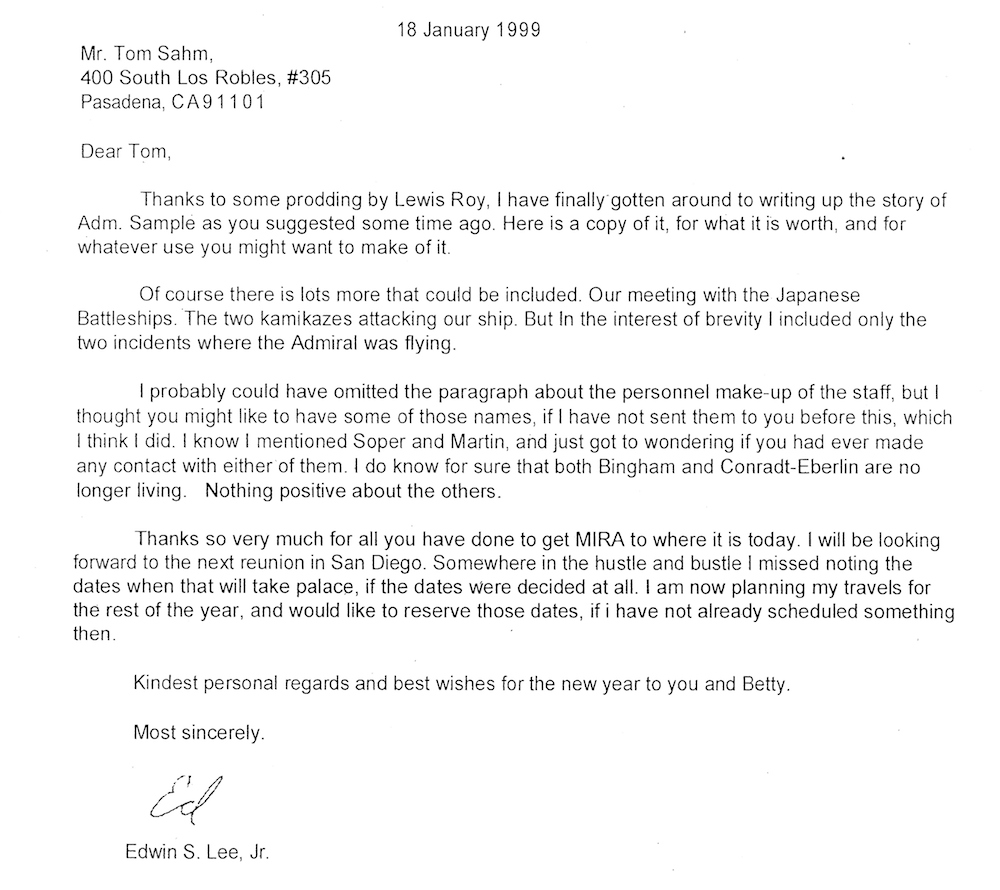
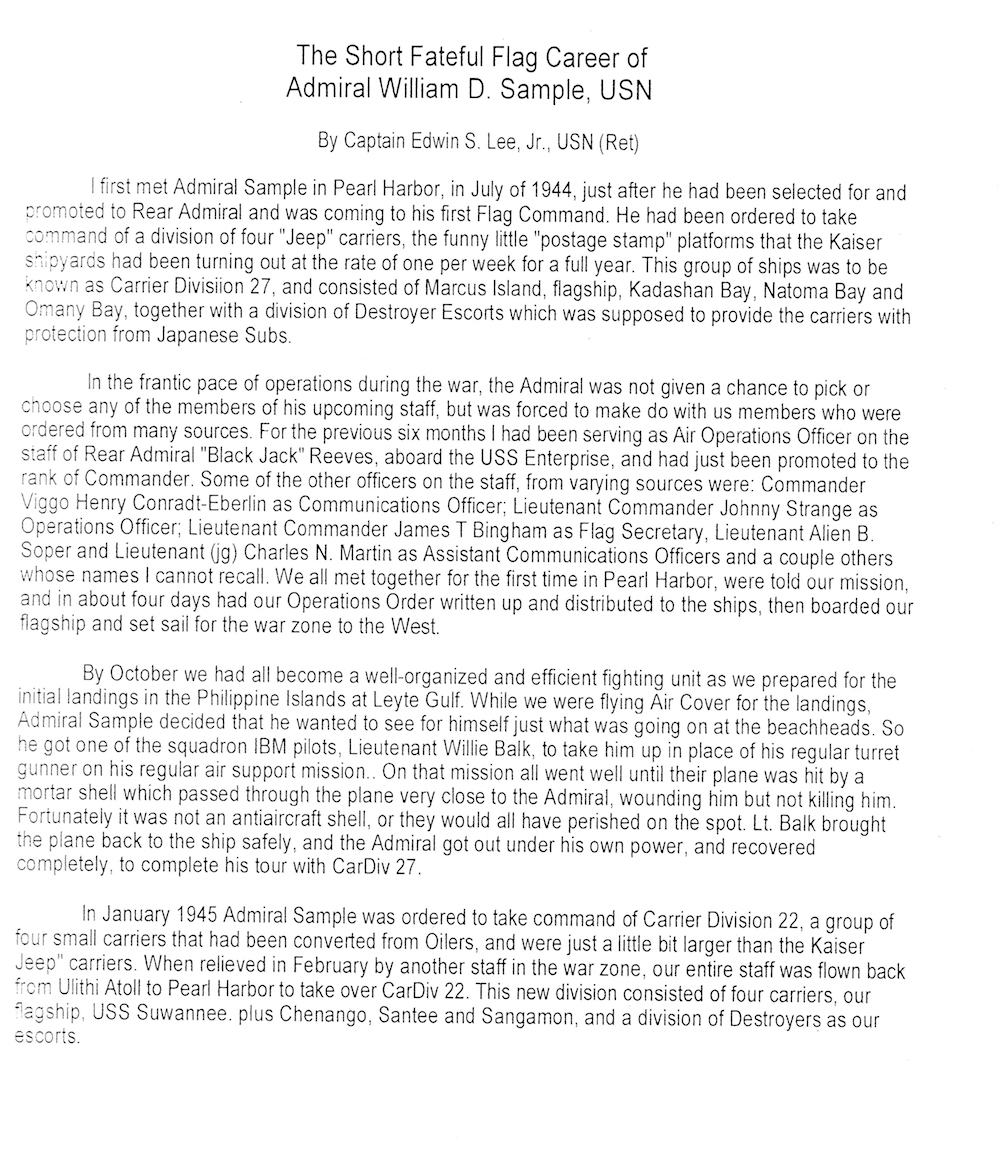
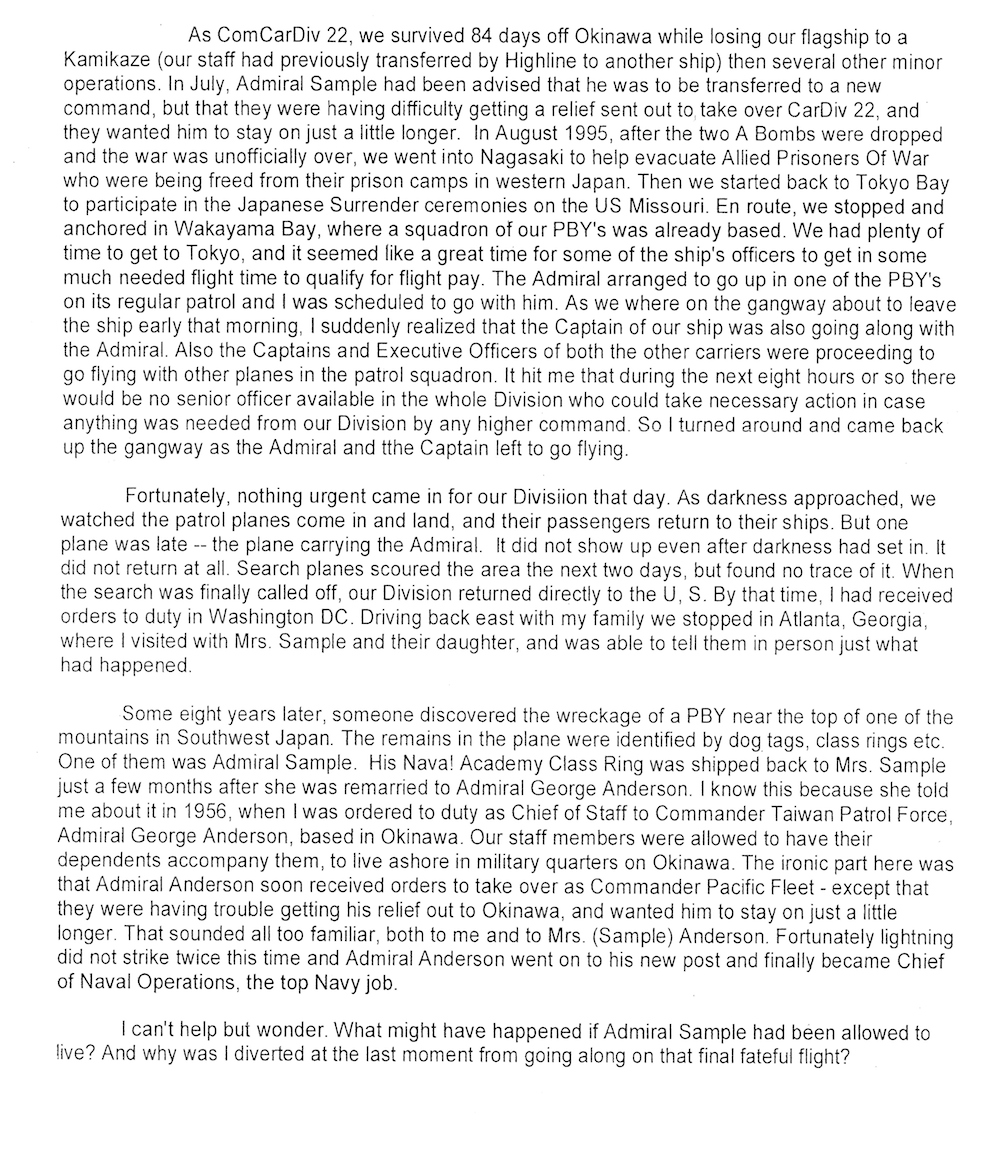
Note 3. Jim Edinger’s Promotion

Note 4. Recovery of Downed Airmen
In addition to providing anti-submarine and anti-aircraft protection for the carriers, the destroyer screen had the very important duty of providing plane-guard coverage astern of each carrier during flight operations. Any time there was a mishap during take-off or landing operations, there was always a DD or DE on hand to effect a quick rescue of the plane’s crew. There is an excellent description of carrier flight operations from the perspective of a DE on page 114 of Little Ship, Big War, written by Commander E.P. Stafford who served aboard the Abercrombie, one of the DEs in CarDiv 27, during the Philippine campaigns. Incidentally, Jack Chrystal’s daughter Cathy Chrystal DeCoster’s father-in-law, Cyrus DeCoster, was the Antisubmarine Warfare Officer aboard Abercrombie during this period.
I don’t recall which of the escort destroyers picked up Tony Peyou and his crew the morning we swapped planes, but Commander Stafford gives an account of picking up Jerry Bridge, one of our fighter pilots, on the morning of October 23. This is on page 121 of Little Ship, Big War. Apparently, during this pre-dawn take-off, Jerry’s wing hit part of the carrier’s superstructure, causing the plane to cartwheel into the sea. I could be mistaken, but I think Jerry decided to give up flying shortly after this. This account is well worth reading.
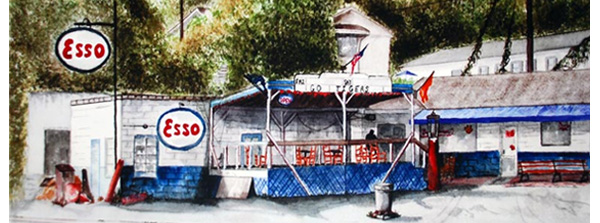
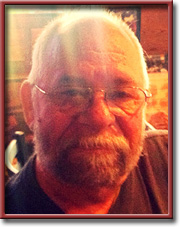
8 Comments
Randy Rayfield
Ted, as usual a most interesting read. Enjoyed the part about letting the Admiral shoot at some Japs. Never thought about it but having your engine “not start” after catapulting off the deck would be a bad thing. The story about your father most exciting experience was a classic. Your are making the story real. Good work.
Ted Balk
Thank you, Randy. Praise from a great raconteur is high praise, indeed. I would love to find the article that reporter wrote in the Augusta paper about the “most exciting experience.” I’m sure it was a hit with the family.
Jean Nolan
This is WONDERFUL! It has particular appeal for me, as my husband, years after your dad, obviously, was a crew chief on a CH-46 helicopter, flying out of DaNang – and is color-deficient. (There are stories there, too!) This comment was delayed, as I spent last night reading – as opposed to just seeing – all of the parts of the story already published. What a collection of tales. Thank yous are due the man himself, and his loving and careful editor(s). We look forward to further adventures.
Ted Balk
Jean, thank you so much for taking the time to go back to the beginning and reading the whole story – thus far, and for giving credit to the original author. The next chapter will cover the largest Naval battle in history – The Battle of Leyte Gulf.
I travelled all over ‘Nam in all types of aircraft, from Hueys to Air America Cessnas, but I never had the pleasure of riding in a Chinook, and I’m also thankful that I only was in Da Nang once. I’m sure your husband has many stories about his time there, as well as how he got through the eye tests. You’ll have to pry those out of him for us.
Alan Ichiyasu
THEO:
I READ THE OTHER STUFF YOU WROTE ABOUT COLOR BLINDNESS. THE STORY CONTINUES TO SMOKE…!
THE CORSAIR. WHAT A BEAUTIFUL PLANE. STRANGE HOW WEAPONS CAN BE SO VISUALLY ATTRACTIVE. AND WE KNOW THEY’RE NOT DESIGNED AND DESIGNED FOR LOOKS. MADE TO DRIVE RAILROAD SPIKES INTO THE TRACKS.
THANK YOU,
ALAN
Ted Balk
Thanks, Alan! I’ll try to keep the tempo going for a few more installments.
The Architectural maxim, “form follows function” is always the driving influence on appearance in weapons design. It’s amazing how often the beasts of destruction turn out to be beautiful, as well. I think part of it is that people are drawn to power, and nothing says power like a war machine. But I agree, the lines of an F4F Corsair are just plain beautiful.
Ted
Tim Bayer
Ted,
I’m just catching up on unread articles and backtracked to this post. The series is very entertaining. I’m looking forward to the next installment. Keep ’em coming.
T.
Ted Balk
Thank you, Tim. I’m working now on the next installment, which covers my father’s perspective on the Naval battle at Leyte Gulf, which is frequently referred to the largest Naval engagement ever.
Ted